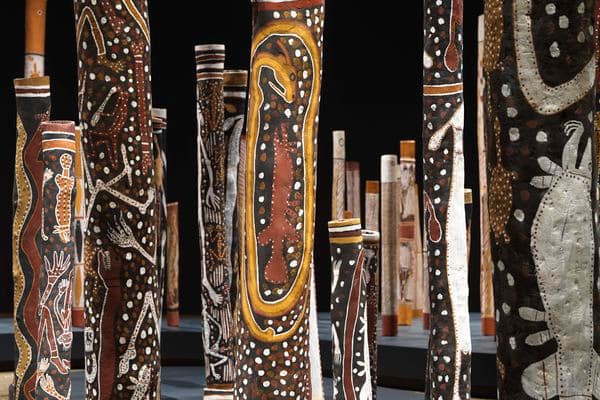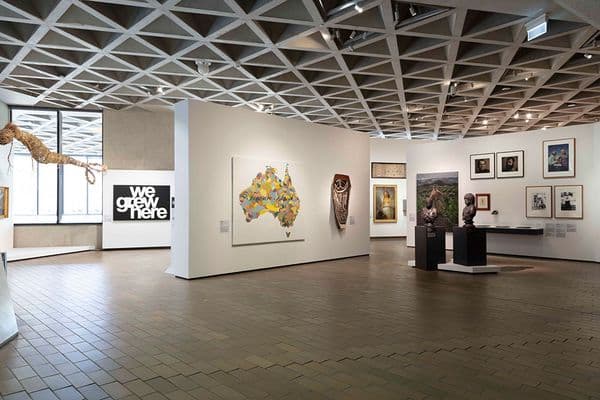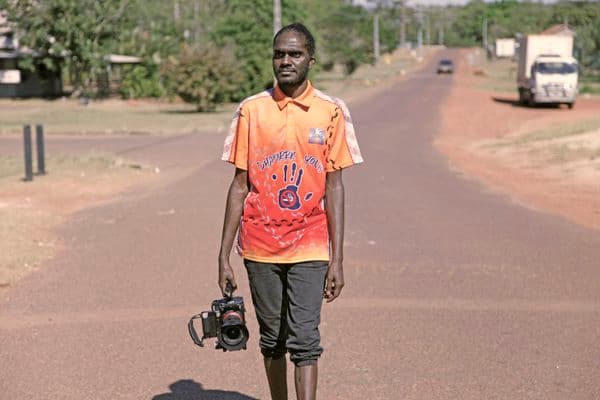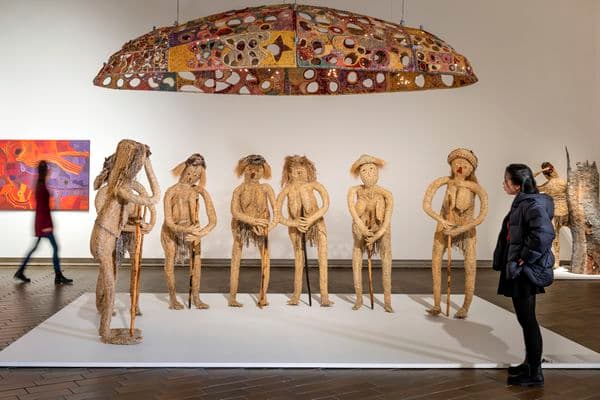Urban Focus
Aboriginal and Torres Strait Islander Art from the Urban Areas of Australia
15 Oct 1994 – 27 Nov 1994

Ron Hurley, Goreng Goreng people, Gilbert Bowling, 1990, National Gallery of Australia, Kamberri/Canberra, Purchased 1991. © Ron Hurley/Copyright Agency.
Curatorial Essay
From Charcoal Lane
As Aboriginal art gradually became accepted into the public domain in the 1970s and 1980s, Australia witnessed the emergence of artists whose work came to be termed 'urban' Aboriginal art. The exhibition Koori Art '84, held at Artspace in Sydney, employed the south-eastern term 'Koori', meaning 'Aboriginal person', to encompass a new generation of artists, most of whom were painters, and who shared common experiences. Many had studied at Western art schools and used Western media: they redefined and articulated their identity as Aboriginal people from a viewpoint at once distinct and contrary to the Western cultural history, propagated by their white Australian teachers, and the predominantly European milieu in which they lived. In fact, many of these artists were from rural backgrounds, and some from so-called traditional communities, who by necessity had migrated to the major southern cities to study. As a body of artists they attracted the attention of the art world which perceived their sole unifying common traits to be their Aboriginality and their geographical location. Art commentators labelled them 'urban Aboriginal' artists.
This white Australian response was foreshadowed in a way by developing attitudes to, and definitions of what was perceived to be the real ‘Aborigine’ — hence 'real Aboriginal art' from the 1960s on. Since the early part of the twentieth century Aboriginal people have been governed according to strict and demeaning official 'measurements' of race — full bloods, half-castes, quadroons, octoroons and so on — in the various states and territories. Although in the nineteenth century Tommy McRae, William Barak and others were recognised both as Aboriginal and as artists, by the time Australia became a federation in 1901 the biased distinctions of racial purity allowed historians to blindly record the existence of no 'real' Aboriginal people in the urban areas of the country — hence no 'authentic' Aboriginal art in those regions.
Paradoxically, the so-called 'White Australia' policy, a policy controlling the 'racial purity' of immigrants, also dictated attitudes towards Aboriginal people for much of the twentieth century. However, notions of authenticity began to change after World War II, in particular as the Australian population diversified: from the 'ten pound pom' assisted passage migrants from the British Isles, to people who, though 'legally' white, hailed from southern Europe, until the policy of a white Australia was dropped to allow into the country immigrants of north African, Middle Eastern and Asian backgrounds.
As a result of the mammoth social and political advances gained by Aboriginal people in the 1960s and 1970s, the Commonwealth Government's definition of an Aboriginal person was altered to include a person of Aboriginal descent who identified as Aboriginal and who was recognised by their community as such. This, in many ways, paralleled social awareness movements worldwide which were related to the political activities of the civil rights movements in the United States, the Vietnam war and both the green and the women's movements which effectively politicised the work of many artists. 'Artists of colour' emerged in the 1970s and, more recently, 'black American' and 'black British' artists began operating within the mainstream art world tradition. These events provided a context in which similar developments occurred within Australia, and aesthetic shifts throughout the white Australian art world allowed a more serious debate on the overtly political Aboriginal art of urban-based artists.
Many of the Aboriginal artists in the urban areas were at the forefront of the indigenous political movements of the period — social justice issues and the land rights push were integral to the struggle to have their identity acknowledged. Jeffrey Samuels, Arone Raymond Meeks, Kevin Gilbert and others such as Gordon Syron were included in the 'Apmira' series of fundraising exhibitions to fight for the general Aboriginal cause in the 1970s in Sydney. Lin Onus was involved in a similar way in Melbourne at the same time. Many of these artists made contact with more traditionally oriented communities and framed their art pieces around or out of themes related to that experience. It was in many ways a bitter experience as the acceptance of urban-based artists depended upon a patronising view of what was still perceived to be a 'curiosity', and largely to be bad art.
For urban-based artists the real breakthrough came in the 1980s. Audiences were becoming more receptive, they were relatively more educated, certainly more politically and artistically confident and adventurous. Since 1979 Sydney had hosted several Biennales which included Aboriginal art. The Australian survey show Perspecta included such work in 1983 and in most following showings.
After the Koori Art '84 show, the sense of community amongst its Sydney participants grew until in 1987, they formed their own co-operative — Boomalli Aboriginal Artists Ko-operative. Their banner title was from the Kamilaroi people from New South Wales: Boomalli meaning 'to strike'. The co-operative provided a modest inner-city studio and exhibiting space as well as a meeting place for its members. Art workshops concerned with community art practice were established separately at the Eora Centre in nearby Redfern.
By the late 1980s other centres had sprung up in Perth, Adelaide and Cairns. Alongside these developments a significant number of Aboriginal artists were operating independently within the general system whilst retaining an individual indigenous status. In Melbourne, for example, because of a more geographically dispersed artist population the need was never felt for such centralisation. Some artists however did work in community projects associated with Swinburne Institute of Technology and more so later at Koori Kollij. Trevor Nickolls taught there in the late 1970s and 1980s and Lin Onus developed his comic book character, Kaptain Koori, at this time. Both had worked as artists in the community, as had Karen Casey who also exhibited in group shows as a print maker before turning to painting as her primary art practice. In other rural areas and other states, individuals of great inner conviction took to the visual arts using many mediums and styles.
As with much issue-based art, these works move from social realist and heroic imagery — a reflection of the vitality of the times — to a period where deeper and more subtle readings could be taken in and digested. It could indeed be said that such confrontationalist statements were needed to shock the audience into the reality of Australian Aboriginal history and set a platform for a more willing discourse within the art establishment and the general public domain.
The new self-perception of Aboriginality which developed in the 1960s and 1970s — and the rise of an Aboriginal middle class — was about identity, about being noticed. The momentous events of this time were largely recorded by non-Aboriginal people. Mervyn Bishop is an exception: his historic photograph showing Prime Minister Gough Whitlam returning land to its rightful owners by pouring earth into the hands of Vincent Lingiari, the Kurindji leader, is a seminal image symbolic of Aboriginal achievements. The shift towards land rights, culminating in the Yirrkala court case and the Northern Territory Land Rights Act of 1976, is referred to in several works including Avril Quaill's poster Trespassers keep out!, which features the Aboriginal flag, and Robert Campbell Jr's painting of the Aboriginal tent embassy set up outside Parliament House in Canberra in 1972. But the struggle continues. The Aboriginal demonstrations of cultural strength which surfaced in 1988, during the bicentennial year, are documented in the photographs of Kevin Gilbert and Brenda L. Croft.
During the last few years a re-evaluation of Australian history has begun to take account of the Aboriginal perspective which differs greatly from that of the 'official' histories. Indeed, the impetus to paint for Robert Campbell Jr was to teach his family the Aboriginal history of Australia which couldn't be found in schoolbooks. Images of the oppression of indigenous people appear in Alice
Hinton Bateup's Dispossessed, Jenuarrie's Homeless, and in Gordon Bennett's work, culminating in the deaths in custody issues boldly revealed in Trevor Nickolls's painting. The original European invasion is seen by these artists for what it was; Fiona Foley's Lost Badtjalas — severed hair and Milton Budge's Ba! Ba! Ku-Ring-Gai Chase? deal with direct extermination, while the dire consequences of policies of assimilation are reflected in the work of Richard Bell — the breaking up of families and the taking away of children.
Gordon Bennett and Richard Bell explore the development of negative stereotypes of Aboriginal people which have been created since the coming of Europeans, and which led to popular misconceptions and downright lies concerning indigenous people. The individual and family histories reflecting the realities of being Aboriginal in a European-dominated society, and acting against stereotypical views and official histories, are captured in Trevor Nickolls's Machinetime Dreamtime and Ian W. Abdulla's painting, while Ricky Maynard's photographs challenge the notion that Aboriginal people in Tasmania died out last century.
A vital society is never static but continuously re-evaluating traditional lifestyles in contemporary settings. The persistence of traditional values and ideas in rural and urban Australia is little understood and artists strive for these to be recognised.
The prints of Badger Bates and Pooaraar, the sculptures of David Jangalinji, Riek Roser and Laurie Nilsen, Thancoupie’s use of clay, the adaptations of possum-skin cloak designs by Euphemia Bostoek and Lawrence Leslie, and the paintings of Bronwyn Bancroft re-invent and interpret traditional forms.
The relationship to the land is a constant in Aboriginal culture — the idea of caring for country, of fulfilling one's responsibilities to the land through art is central to the work of Arone Raymond Meeks, Judy Watson, Kerry Giles and Sally Morgan. While this exhibition focuses on the work of a particular group of Aboriginal and Torres Strait Islander artists who have come to the fore in latter day Australia, the focus of their art is not always towards the urban areas in which they live but towards the physical, emotional and spiritual country of their heritage.
The selection of works in Urban Focus encompasses and outlines much of this recent history, from relatively early works such as Kevin Gilbert's nostalgic but poignant prints, originally made in the late 1960s, to the present phase of this movement: the sophisticated work of Judy Watson, Gordon Bennett and others. While the exhibition is not intended to be a definitive survey it takes an appreciative look at this phenomenon in the work of a core group. while simultaneously casting wider to encompass the emergence of like artists across the continent. The scope and range of subject matter reflect the concerns and aspirations of who share both a common heritage and unique views on Australian life and society – views which were once denied an audience.
Dion Mundine
Consultant Curator
Wally Caruana
Curator of Aboriginal and Torres Strait Islander Art









///national-gallery-of-australia/media/dd/images/20210604_James_Tylor_001.jpg)

